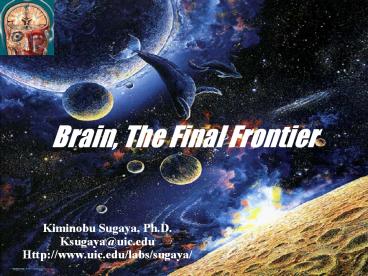Brain, The Final Frontier PowerPoint PPT Presentation
1 / 66
Title: Brain, The Final Frontier
1
Brain, The Final Frontier
- Kiminobu Sugaya, Ph.D.
- Ksugaya_at_uic.edu
- Http//www.uic.edu/labs/sugaya/
2
Homeostasis
Response to Outside and Inside Environment
3
(No Transcript)
4
(No Transcript)
5
Nervous System
- Central Nervous System (CNS)
- Brain
- Spinal Cord
- Olfactory
- Optic nerves
- Almost no regeneration?????
- Peripheral Nervous system (PNS)
- Autonomic Nervous System Sympathetic Parasympa
thetic - Somatic
- Cranial Nerves (3-12)
- Some regeneration
6
(No Transcript)
7
What are the components of CNS ?
- Neuron
- Glia
8
Neurons
Cells that specialized for transmitted chemical
and electrical signals from one part of the body
to another.
9
Impulse
Presynaptic neuron
Vesicle
Transmitters
Synaptic cleft
Postsynaptic neuron
Receptors
Postsynaptic activity
10
Classifying Neurons
- Number of axons and dendrites
- Type of connections
- Type of neurotransmitter
- unipolar, bipolar, multipolar
- sensory, motor, interneurons
- Acetylcholin, Dopamine
11
Glia Cells
- Astrocytes
- Oligodendrocytes
- Microglia
- Ependymal cells
12
Possible Roles of Glia Cells
- supporting element
- producing myelin
- scavengers - removing debris
- buffer
- guide migration in course of development
- help to form special lining in the capillaries -
Blood Brain Barrier (BBB)
13
Anyone touched human brain?
14
bumps gyri grooves sulci (fissures)
15
- Is the brain hard or soft?
- The brain is soft.
- How it is protected?
16
(No Transcript)
17
(No Transcript)
18
(No Transcript)
19
CSF
20
Ventricles
21
Blood-Brain barrier
22
Cortical layer
I
II
III
IV
Blood vessel
V
Neuron
VI
23
(No Transcript)
24
Mapping the brain function
- How much of the brain are we using?
- 10
- 50
- 100
25
(No Transcript)
26
(No Transcript)
27
(No Transcript)
28
(No Transcript)
29
Evidence for localization
- Broca (1861)
- Expressive Aphsia
- can understand but cannot speak
- Wernicke (1876)
- Receptive Aphsia
- can speak but cannot understand
30
(No Transcript)
31
(No Transcript)
32
(No Transcript)
33
(No Transcript)
34
Left Auditory cortex
Right Auditory cortex
Medial geniculate nucleus
Cochlea
Inferior colliculus
Auditory nerve fiber
Superior Olivary nucleus
Ipsilateral Cochlear nucleus
35
Optic nerve
Optic chiasm
Optic tract
Lateral geniculate nucleus
Optic radiation
Primary visual cortex
36
What you see, what you get
Line
Retina
Lateral geniculate nucleus
Primary Visual Cortex (V1)
37
(No Transcript)
38
(No Transcript)
39
(No Transcript)
40
(No Transcript)
41
Processing of sound
42
(No Transcript)
43
(No Transcript)
44
(No Transcript)
45
(No Transcript)
46
(No Transcript)
47
(No Transcript)
48
Hippocampus
Amygdala
49
(No Transcript)
50
Coordination and control of voluntary movement.
51
Nerve pathway of cerebral hemispheres. Auditory
and Visual reflex centers. Cranial Nerves CN III
- Oculomotor (Related to eye movement), motor.
CN IV - Trochlear (Superior oblique muscle of
the eye which rotates the eye down and out),
motor.
52
Respiratory Center. Cranial Nerves CN V -
Trigeminal (Skin of face, tongue, teeth muscle
of mastication), motor and sensory. CN VI -
Abducens (Lateral rectus muscle of eye which
rotates eye outward), motor. CN VII - Facial
(Muscles of expression), motor and sensory. CN
VIII - Acoustic (Internal auditory passage),
sensory.
53
Crossing of motor tracts. Cardiac
Center. Respiratory Center. Vasomotor (nerves
having muscular control of the blood vessel
walls) Center? Centers for cough, gag, swallow,
and vomit. Cranial Nerves CN IX -
Glossopharyneal (Muscles and mucous membranes of
pharynx, the constricted openings from the mouth
and the oral pharynx and the posterior third of
tongue.), mixed. CN X - Vagus (Pharynx,
larynx, heart, lungs, stomach), mixed. CN XI
- Accessory (Rotation of the head and shoulder),
motor. CN XII - Hypoglossal (Intrinsic
muscles of the tongue), motor.
54
(No Transcript)
55
(No Transcript)
56
(No Transcript)
57
(No Transcript)
58
Positron Emission Tomography
The PET scan on the left shows two areas of the
brain (red and yellow) that become particularly
active when volunteers read words on a video
screen the primary visual cortex and an
additional part of the visual system, both in the
back of the left hemisphere. Other brain regions
become especially active when subjects hear words
through ear-phones, as seen in the PET scan on
the right. To create these images, researchers
gave volunteers injections of radioactive water
and then placed them, head first, into a
doughnut-shaped PET scanner. Since brain activity
involves an increase in blood flow, more blood
and radioactive water streamed into the areas of
the volunteers' brains that were most active
while they saw or heard words.
59
(No Transcript)
60
(No Transcript)
61
(No Transcript)
62
fMRI
Very mild activity (blue to red areas) is
recorded in certain regions of a volunteer's
brain as he hears a series of sharp but
meaningless clicks (see the white box on the left
of the first picture.) When he listened to
instrumental music, the same region of the man's
brain became much more active (orange to yellow
areas), as shown in the white box on the left of
the second picture. But in addition, several new
areas of his brain were activated. This increase
in activity reflected the richer meaning of the
sounds.
63
Magnetoencephalography (MEG) and MRI
64
Electroencephalography (EEG)
65
(No Transcript)
66
Brain, The Final Frontier
Kiminobu Sugaya, Ph.D. Ksugaya_at_uic.edu Http//www.
uic.edu/labs/sugaya/

